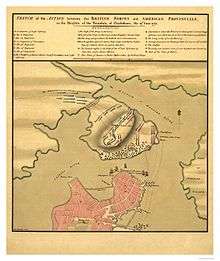Charlestown Neck

The Charlestown Neck was an isthmus connecting the formerly independent city of Charlestown, Massachusetts to the mainland at present-day Sullivan Square in Middlesex County. When Charlestown was first settled by British colonists it was surrounded on nearly all sides by water. Only a small strip of land called "the neck" connected what is now Charlestown to what would become Somerville.
History
As with Boston's founding on the Shawmut Peninsula, Charlestown was originally settled on a small peninsula (Indian name Mishawum) accessible by land only via a small isthmus.[1] While Charlestown was then largely separated from the mainland by an inlet of the Charles River later called Prison Point Bay, and by what was later called the Miller's River, these bodies of water have since been completely obscured by landfill and land reclamation over the late 19th and early 20th centuries.[2][3]
From the 1630s until the early 1800s the residential and commercial life of Charlestown was mostly focused on Boston Harbor. The Charlestown Peninsula grew into a major port community over the 18th century, and the inhabitants had little use for the rural area "beyond the neck", aside from occasional agricultural pursuits or quarrying. The completion of the 27 mile (43 km) Middlesex Canal in 1803 shifted Charlestown’s attention to its western hinterlands. The canal terminated at the Charlestown Neck, which precipitated the Neck's transition into a regional transportation hub. This would remain the case for at least another two centuries.[4]
Although the peninsula and the mainland were technically one city, by the 1830s the rural farmers making a living "beyond the neck" had begun to resent their industrializing counterparts (and vice versa). Political separation took place in 1842, with Somerville becoming its own township. However, it was the railroads that would eventually doom the Charlestown Neck. Over the second half of the 19th century, industry would flourish throughout the region, necessitating the construction of good transportation infrastructure and reliable distribution networks. Railroads saw the Neck as a key transit point for manufactured goods produced in the Merrimack Valley, with easy access to Boston, Charlestown and Cambridge markets.
By the 1870s Sullivan Station was under construction and railroads began filling in area wetlands in order to lay down tracks. Industrialists leveled Cobble Hill in Brickbottom (one of Somerville's original "seven hills") to fill the wetlands. Additionally, meat-packing was taking off at the time, and slaughterhouses would dispose of waste directly into water.[5] Between 1855 and 1869, the Miller's River district became "malodorous and unenviable"[6] on account of the slaughterhouses.
In the late 19th century, Miller's River had become a dumping ground such that the stench and resulting health problems prompted some of the first public health-based anti-pollution environmental laws in Massachusetts; they are seen as a precedent for later environmental laws that would be introduced throughout the United States.[7] The inaccessible and degraded industrial landscape around Miller's River and along the lower Charles River basin became known during the late 19th and the 20th centuries as "the Lost Half-Mile". The City of Cambridge saw Miller's River as a health risk and ordered it filled.[8]
By 1886, the open water and wetlands between Charlestown and Cambridge had largely been filled in as factories sprang up in the area. Today, the Charlestown Neck and associated bodies of water are non-existent above ground.[9]
See also
- Dorchester Neck (now South Boston)
References
- ↑ 1775 map detail Retrieved 27 December 2013]
- ↑ Mapping Boston, Krieger, Alex, ed., MIT Press 1999, pp. 16-19.
- ↑ "Sullivan Square: Part 1 of 3". Somerville Development Forum. Somerville Development Forum. Retrieved 6 December 2013.
- ↑ Adams Drake, Samuel (1880). History of Middlesex County, Massachusetts: Containing Carefully Prepared Histories of Every City and Town in the County, Volume 2 (Google eBook). Nabu Press. Retrieved 7 December 2013.
- ↑ "Trends in Somerville: Land Use Technical Report" (PDF). somervillema.gov. City of Somerville Office of Strategic Planning and Community Development. May 2011. Retrieved 11 December 2013.
- ↑ Edward A. Samuels, ed. (1897). Somerville , Past and Present: An Illustrated Historical Souvenir. Henry H. Kimball. Samuels & Kimball. p. 134.
- ↑ "Inventing the Charles River".
- ↑ "Transforming the Lost Half-Mile".
- ↑ James C. O'Connell (2013). The Hub's Metropolis: Greater Boston's Development from Railroad Suburbs to Smart Growth. MIT Press. pp. 116–. ISBN 978-0-262-01875-3.
Additional reading
- Nancy S. Seasholes, Gaining Ground: A History of Landmaking in Boston, The MIT Press (September 28, 2003)
Coordinates: 42°23′1.4″N 71°4′20.1″W / 42.383722°N 71.072250°W